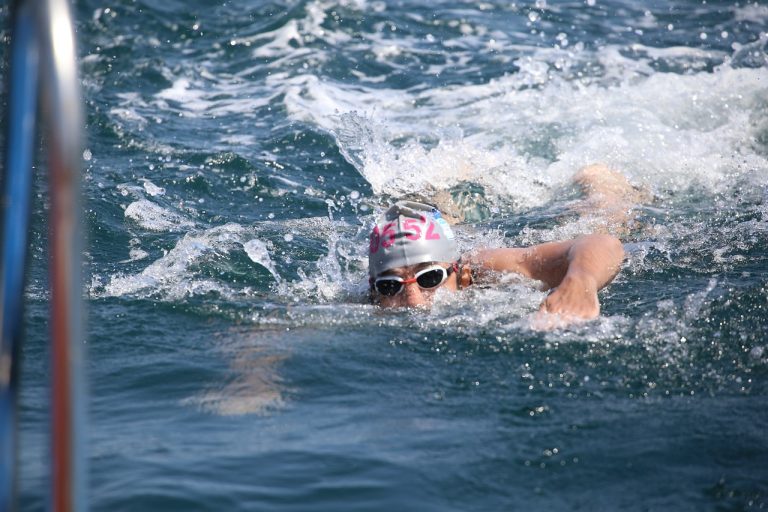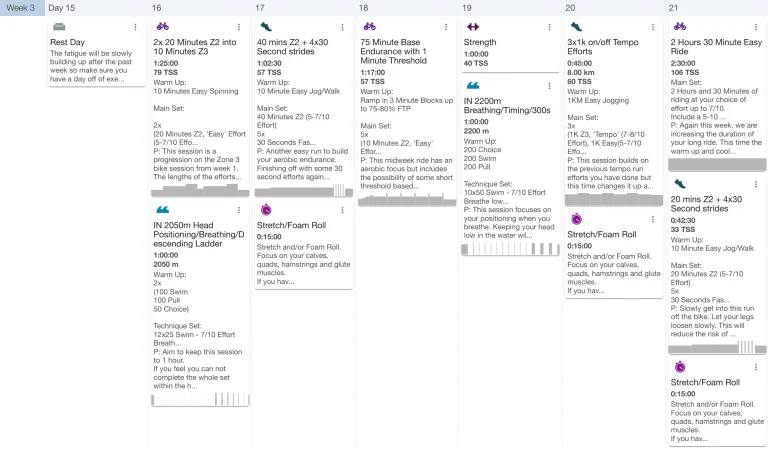Key Takeaways:
- Position yourself where you expect to finish the swim.
- Don’t blindly follow another swimmer and expect them to go the right way.
- Start close to someone you know- they are more likely to be thoughtful!
- Plan your positioning around which direction you breathe and which side to first turn buoy is.
- Pass slower swimmers as quickly as possible.
- Understand currents and tides before you start, they could help you more or hider you less.
Having participated in many open-water swim starts and coached numerous athletes through them, I know that for most, the biggest fear isn’t the swim itself but the chaotic start—being crammed among others, all vying for the same space in the water. I’ve had my fair share of rough mass swim starts that ruined my races, but I’ve since used those experiences to my advantage.
Recently, I had the fastest swim at my local triathlon by steering clear of the chaos caused by a few of my swimming friends. I also applied another technique to comfortably finish in the lead pack during the 2022 World Sprint Triathlon in Montreal.
I’m going to share my advice on what to do—and what not to do—during a swim start, drawing from my years of experience as both a competitor and a coach..

How to Position Yourself for a Mass Swim Start
This might sound obvious, but it’s crucial: if you don’t expect to finish near the front of the swim, don’t start there. You’re likely to get grabbed, hit, and even swum over (mostly unintentionally), slowing your time and making for an unpleasant experience. I’ve seen people panic because they weren’t confident in their swimming abilities to begin with.
The reverse is also true. In my first half-distance triathlon, I started toward the back because my goal was simply to finish. I ended up swimming much farther than necessary and had a few accidental collisions while zigzagging around slower swimmers who had started ahead of me.
Dealing with Anxiety at the Swim Start
It’s normal to have butterflies before a mass swim start. The key is to stay as calm as possible and be proactive about your approach once the gun goes off.
If something throws you off, deal with it in the moment, then refocus on the task at hand. You can’t change what’s already happened, but you can adjust your mindset for the rest of the race.
Put all the tips from this guide into practice, and you’ll know you’ve done everything possible to start out of trouble.

Why You Shouldn’t Follow Other Swimmers Blindly in a Race
With the confusion and adrenaline of a mass swim start, I strongly recommend not blindly following anyone—even a friend. When the starter goes off, instincts take over, rational thinking disappears, and all those technique points you’ve practiced go out the window—you just swim. Everyone else is in the same boat. I’ve seen swimmers veer into oncoming traffic, collide with support kayaks, and even swim into a flock of swans!
Stay aware of where you’re going and what’s around you.

The Benefits of Starting a Swim Near Someone You Know
That said, starting next to a familiar swimmer can be beneficial. They’re more likely to be conscious of your presence, reducing the chance of collisions. Plus, you can shield each other from other swimmers. Before the start, people tend to spread out into available spaces, so if you and your friends occupy one area, others will naturally fill in elsewhere.
Of course, if you’re competitive and don’t want your friends drafting off you, it’s best to keep some distance!
How to Plan Your Swim Start Based on the Course
Know which side of the start line the first turn buoy is on. For example, if you start on the right but the buoy is on the left, you’d better be comfortable breathing to your left—otherwise, merging with other swimmers could be a painful experience. It’s like trying to merge lanes while driving without using your mirrors—you’re just hoping for the best!
I recommend starting on the side where, when you breathe, you can see most of the field.
Avoiding Slower Swimmers and How to Improve Your Swim Time
If you find yourself stuck behind a slower swimmer and feel like you’re coasting, don’t hesitate—pass them as quickly as possible. The longer you stay behind, the further ahead your competitors will get, making it harder to catch up.
I made this mistake last year, spending 400m of a 1500m swim stuck behind someone swimming about 10 seconds per 100m slower than my target pace. By the time I realized I needed to pass, it was too late—I swam the final 1000m alone, trying to close the gap.

Understanding Currents and Tides in Open Water Swims
If you watched the recent Olympics in Paris, you would have seen the impact of currents in the Seine. While I haven’t had to deal with tides personally, I’ve coached athletes who have.
We have a local triathlon in a tidal harbor where the fastest route is to swim out close to the harbor wall and return through the center, where the current pushes swimmers back. Speaking to locals or race officials beforehand can provide valuable insight into the easiest swim path, allowing you to position yourself strategically at the start.
Final Thoughts On Navigating A Mass Swim Start
Even if you do everything right, things can still go wrong. The key is to stay composed and focus on the moment you’re in. The more in control you are mentally, the better your swim will go.
Good luck on your next (or first) mass swim start!





